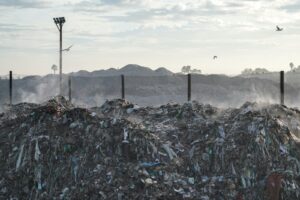Air pollution from agriculture: EU exceeds international limit in 2014
Around 94% of ammonia (NH3) emissions in Europe stem from agriculture, mainly from activities such as manure storage, slurry spreading and the use of fertilisers containing nitrogen. Ammonia contributes to eutrophication — an oversupply of nitrogen — and acidification of ecosystems. It also forms particulate matter in the atmosphere which harms human health.
The Gothenburg Protocol to the UNECE Convention on Long-range Transboundary Air Pollution (LRTAP) contains emission reduction commitments that have to be met from 2010 onwards for NH3 and three other air pollutants: nitrogen oxides (NOx), non-methane volatile organic compounds (NMVOCs), and sulphur oxides (SOx). In addition to emission reduction commitments specified for individual countries, the protocol also specifies reduction commitments for the EU-15.
The annual European Union emission inventory report 1990-2014 under the LRTAP Convention shows that NH3 emissions fell by 24% between 1990 and 2014, but increased in the EU‑28 between 2013 and 2014 by 0.9%. Ammonia emissions from the EU-15 in 2014 were 0.2% higher than the 2010 limit, the first time the EU-15 has exceeded its emission ceiling for this pollutant.
The rise in NH3 emissions in 2014 was mainly due to increases in France, Germany and Spain. Four countries (Finland, Germany, the Netherlands and Spain) also exceeded their individual NH3 ceilings in 2014. (see Figure ES.5). More generally, some countries have also recently improved their estimates of NH3 released from agricultural sources which in some instances has led to an increase in the emissions reported from past years. Better reporting by Member States, including the reporting of new emissions sources, is encouraged.
Emissions of the other main pollutants covered by LRTAP have dropped considerably since 1990, including the three air pollutants primarily responsible for the formation of ground-level ozone (O3). Carbon monoxide (CO), NMVOCs and NOx were reduced by 65%, 60% and 55%, respectively.
Other key findings
- Across the EU-28, SOx emissions have fallen the most with an 88% reduction since 1990. This is a result of a combination of measures including a shift from fuels with high sulphur content towards low-sulphur fuels such as natural gas, flue-gas desulphurisation in industrial facilities and EU directives relating to the sulphur content of certain liquid fuels.
- Emissions of primary particulate matter PM10 and PM2.5 have fallen by 23% and 25%, respectively since 2000, and black carbon (BC) by 42%.
- Emissions of heavy metals such as lead (Pb), cadmium (Cd) and mercury (Hg), as well as the organic pollutants dioxins and furans, hexachlorobenzene (HCB), and polychlorinated biphenyls (PCBs) have also dropped substantially since 1990, by about 66 % or more.
- The EEA member countries Norway and Switzerland, also have emission ceilings specified under the Gothenburg Protocol. In 2014, Norway exceeded its NH3 ceiling. Switzerland complied with all its ceilings.
Background
The Gothenburg Protocol to the LRTAP Convention aims to limit and, as far as possible, gradually reduce and prevent air pollution. It sets emission ‘ceilings’ or limits for a range of air pollutants that have to be met from 2010 onwards. In addition to ceilings specified for individual countries, the 1999 protocol also specifies ceilings for the EU-15. The protocol was amended in 2012 with new emission reduction commitments for 2020 and beyond. The EU-28 has not yet ratified the amended protocol.
Parties to the protocol are allowed to ‘adjust’ their emission estimates to take into account certain changes that have occurred since the emission reduction commitments were originally agreed (for instance, the reporting of emission sources that were unknown at the time the reduction commitments were agreed). For comparisons against the protocol ceilings for 2010, the EEA has taken into account the approved adjusted emission inventory data reported by Belgium, Denmark, Finland, France, Germany Luxembourg and Spain.
The EEA assists the EU by preparing the emissions inventory to be reported under the LRTAP Convention each year.
LRTAP data viewer
The EEA publishes the data from the inventory report in the LRTAP data viewer, a web-based interactive interface from where air pollutant emissions data can be downloaded. The data viewer also displays emission trends and graphics for the main sectors and allows for comparison of emissions from different countries and activities.












